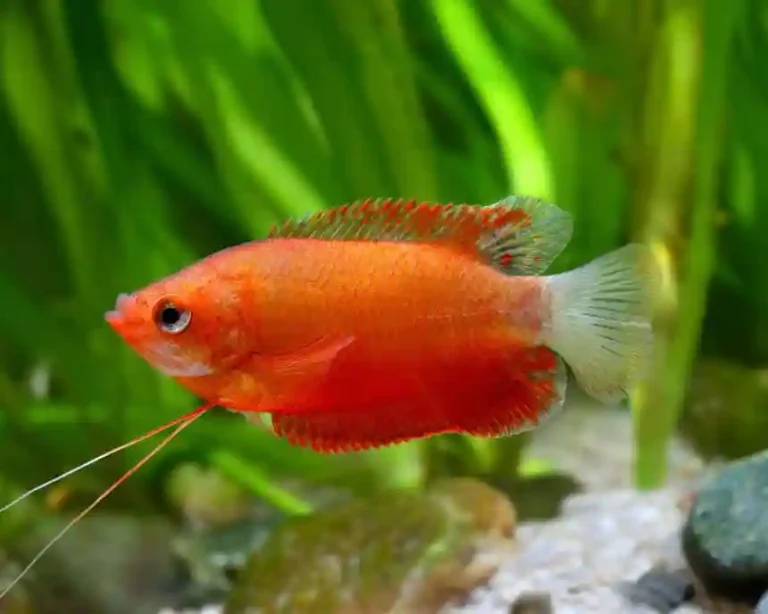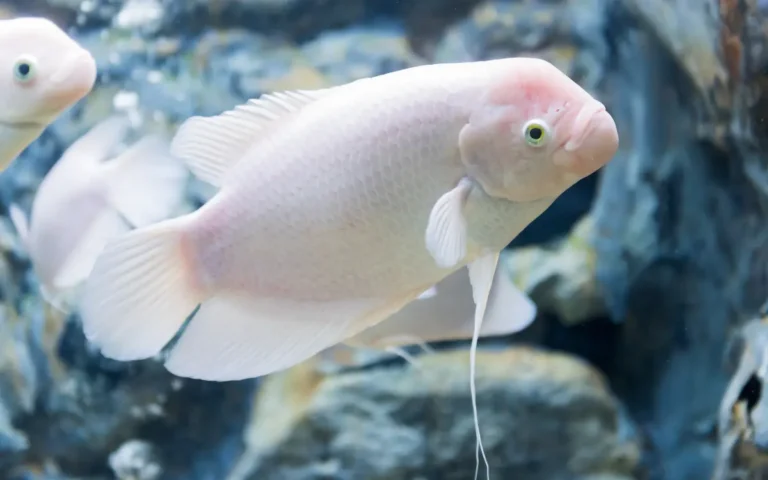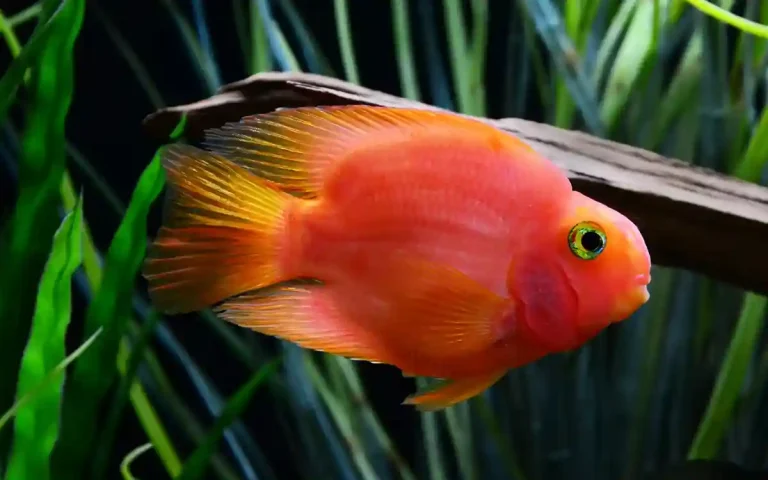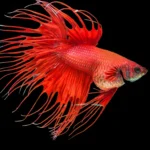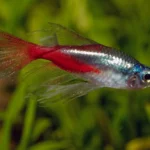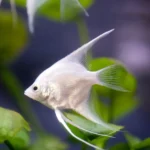Chocolate Gourami (Sphaerichthys osphromenoides) is one of the most striking freshwater fish you can add to an aquarium. With its rich brown coloring, golden vertical bands, and unique mouthbrooding behavior, it stands out even among other gouramis.
But there’s a catch this species is delicate. It thrives only in stable, soft, acidic water and is best suited for aquarists with some experience under their belt. In this guide, you’ll learn everything you need to know about keeping Chocolate Gouramis happy and healthy, from tank setup and diet to tank mates and breeding.

Species Overview
Chocolate Gouramis come from slow-moving blackwater streams and peat swamps in Malaysia, Sumatra, and Borneo. These environments are shaded by dense vegetation and enriched with tannins from decaying leaves, giving the water its characteristic dark tea color.
- Scientific name: Sphaerichthys osphromenoides
- Size: 2–2.5 inches (5–6 cm)
- Lifespan: 4–5 years with proper care
- Temperament: Peaceful but shy
- Coloration: Chocolate-brown body with golden vertical bands and cream edges on the fins
Their small size and peaceful nature make them attractive for community setups, but their sensitivity to water conditions means they aren’t as forgiving as hardier species like the Honey Gourami.
Tank Setup for Chocolate Gourami
Minimum Tank Size
A 20-gallon tank is the minimum for a small group of Chocolate Gouramis. These fish feel more secure in groups of 5–6, and the larger space helps maintain stable water conditions.
For comparison, smaller gouramis such as the Honey Gourami can thrive in a 10-gallon tank, while larger ones like the Pearl Gourami need 30 gallons or more.
Water Conditions
Chocolate Gouramis demand very specific parameters to stay healthy:
- Temperature: 77–84°F (25–29°C)
- pH: 4.0–6.5 (soft, acidic water)
- Hardness: 1–5 dGH
They do best in blackwater setups that mimic their natural environment. Using Indian almond leaves, peat moss, or driftwood will help release tannins and maintain the desired acidity.
Tank Layout
Recreate their native waters with:
- Dense vegetation such as Java fern, cryptocoryne, and floating plants.
- Driftwood and dried leaf litter for hiding spaces.
- Dim or subdued lighting to reduce stress.
This setup not only keeps them comfortable but also enhances their natural colors.
Diet & Feeding Habits
Chocolate Gouramis are omnivores but prefer small, protein-rich foods. In the wild, they feed on tiny insects, larvae, and microorganisms.
- Best foods: Live or frozen daphnia, brine shrimp, mosquito larvae, micro-worms.
- Supplements: High-quality micro-pellets and flakes.
- Feeding frequency: 2–3 small meals daily.
They can be finicky eaters at first, so offering live food helps them settle in. Once they adjust, a varied diet keeps them healthy and enhances their coloration.
Behavior & Temperament
Chocolate Gouramis are shy, slow-moving, and very gentle. They often hover near plants and rarely compete aggressively for food.
They differ from more active gouramis like the Blue Gourami, which can be territorial. Keeping them in a calm environment with peaceful tank mates ensures they don’t become stressed.
Since they are schooling fish, keep at least 5 together. A lone Chocolate Gourami will become timid and stressed.
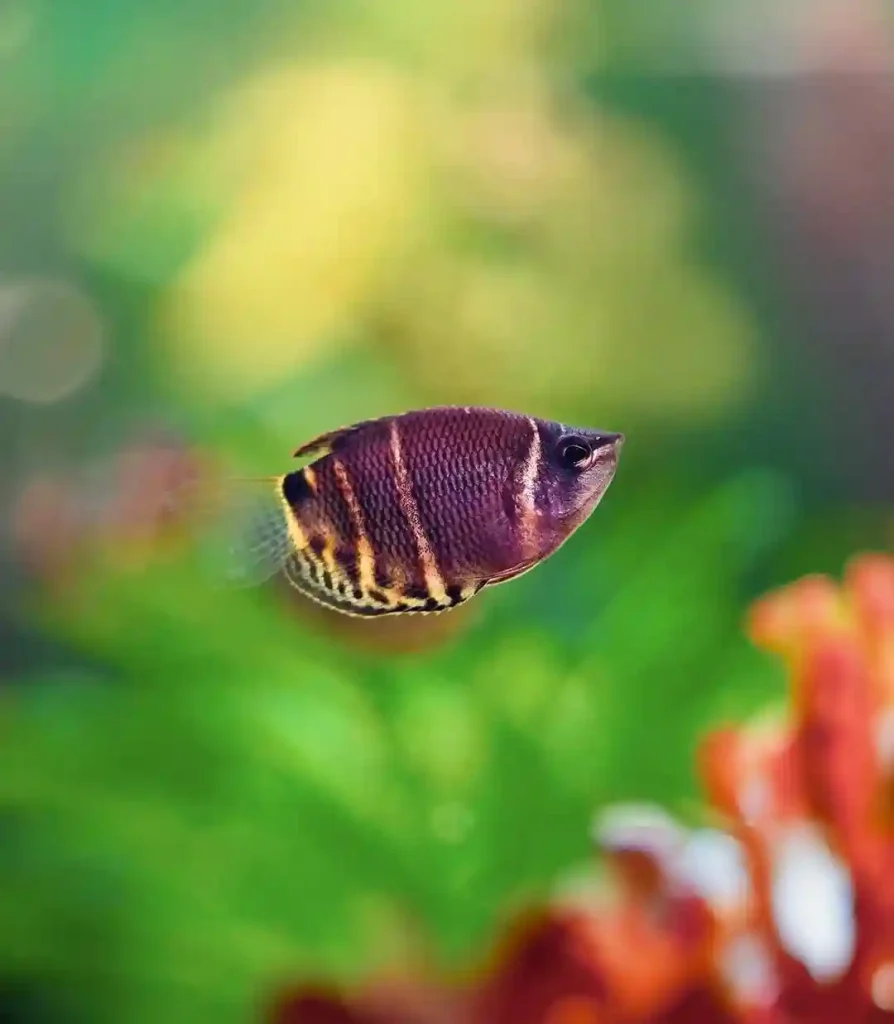
Tank Mates for Chocolate Gourami
Because of their gentle nature, Chocolate Gouramis should only be housed with peaceful species.
Great companions include:
- Rasboras (Harlequin, Chili)
- Neon or Cardinal Tetras
- Corydoras catfish
- Kuhli loaches
Avoid:
- Aggressive cichlids
- Large barbs
- Fin-nippers
They can also live with other gourami species in the right setup. If you’re considering mixing gouramis, check out our guides for:
Just remember, those species grow much larger, so a spacious tank is a must.
Breeding Chocolate Gourami
One of the most fascinating aspects of Chocolate Gouramis is their breeding behavior. Unlike many other gouramis that are bubble-nest builders, this species is a mouthbrooder.
- Role reversal: The female carries the fertilized eggs in her mouth, not the male.
- Incubation: She holds them for about two weeks before releasing free-swimming fry.
- Raising fry: Start them on infusoria or liquid fry food, then transition to baby brine shrimp.
Because the female doesn’t eat while mouthbrooding, breeding takes a lot out of her. It’s important to provide plenty of rest and good food afterward.
Common Health Issues
Chocolate Gouramis are more prone to illness than other gouramis if their water isn’t pristine.
- Ich (white spot disease): Very common if temperatures drop suddenly.
- Bacterial infections: Triggered by poor water quality.
- Stress-related weakness: Caused by aggressive tank mates or unstable conditions.
The best prevention is consistent maintenance—frequent water changes, soft acidic water, and avoiding stressful environments.
Pros & Cons of Keeping Chocolate Gourami
Pros
- Stunning appearance with chocolate-brown and gold patterns.
- Unique mouthbrooding behavior.
- Peaceful, non-aggressive temperament.
Cons
- Very sensitive to water conditions.
- Not suitable for beginners.
- Prone to stress and disease if kept with wrong tank mates.
Are Chocolate Gouramis Right for You?
If you’re an aquarist looking for a challenge and want to create a natural blackwater setup, the Chocolate Gourami will reward you with fascinating behavior and beauty.
However, if you’re just starting out, you may want to begin with a hardier species such as the Honey Gourami or Pearl Gourami before attempting Chocolate Gouramis.
FAQs About Chocolate Gourami
How big do Chocolate Gouramis get?
They reach about 2–2.5 inches, making them one of the smaller gouramis.
Are Chocolate Gouramis good for beginners?
No, they are best suited for intermediate to advanced aquarists because of their sensitivity.
Can Chocolate Gouramis live with bettas?
It’s not recommended. Bettas can be too aggressive and stress out Chocolate Gouramis.
How many Chocolate Gouramis should I keep together?
Keep them in groups of 5–6 for comfort and reduced stress.
Do Chocolate Gouramis need live food?
They strongly prefer it, especially when first introduced. Over time, they may accept quality frozen or pellet food.
Final Thoughts
Chocolate Gouramis are not the easiest fish to care for, but their unique charm makes them a prized addition for dedicated aquarists. With the right tank setup, stable blackwater conditions, and careful feeding, these little gouramis can live long, healthy lives.

